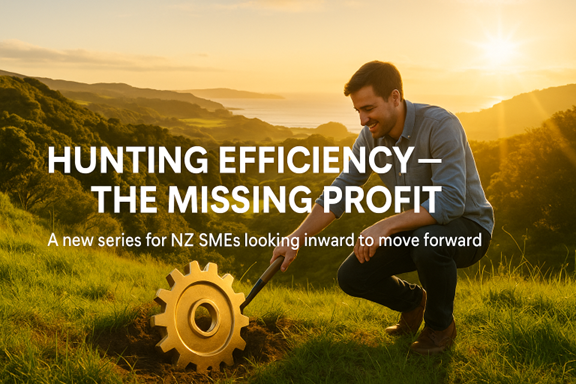25. Compliance as an Opportunity, Not a Cost
A series about business efficiency, finding profit and how to get there
Introduction
Say the word “compliance” in most SMEs and you’ll get an eye roll. It’s often seen as a necessary evil - a cost centre with no return, a distraction from “real” business.But that mindset is not just limiting, it’s expensive.
Yes, compliance takes time. Yes, it involves forms, policies and checks. But when approached strategically, compliance can -
Build trust with customers and suppliers
Protect your team and brand
Unlock access to larger contracts or tenders
Drive operational clarity
Reduce risk, rework and insurance costs
In short compliance done well is efficiency in disguise. It makes you a safer, stronger, more scalable business.
Actions to Be Taken
Here’s how to shift from reactive compliance to proactive, profit-aligned governance.
Conduct a Compliance Health Check
Start with the basics -
Are your employment agreements, policies and H&S plans up to date?
Are financial and tax obligations being met on time?
Are you collecting and storing customer data in line with privacy law (e.g. NZ’s Privacy Act)?
Do you have clear policies for anti-bullying, harassment, cyber safety and risk management?
Create a checklist. Map out what’s in place, what’s missing and what’s overdue.
Reframe Compliance as Trust Infrastructure
Every compliance process is a chance to say -
“We take your safety seriously.”
“You can count on us to do the right thing.”
“We’re a business that doesn’t cut corners.”
This is especially important when dealing with -
Government or corporate contracts
Export markets
High-trust services like finance, childcare, aged care, or health
Your compliance is part of your brand promise.
Streamline and Systemise
Use technology to make compliance easier -
Digital timesheets and payroll
Automated document retention and cloud storage
Health and safety reporting apps
Online policy hubs for staff access
Systemising reduces risk, saves time and keeps your business audit-ready.
Make Compliance Part of Culture
Don’t treat compliance like a set of rules handed down from above. Embed it into how the business operates -
Talk about the “why” behind policies - not just the “what”
Empower staff to report risks without fear
Encourage feedback on how to make compliance more user-friendly
Celebrate teams that demonstrate safe, ethical, or responsible behaviour
Culture-driven compliance is more durable than checklist compliance.
Keep an Eye on Opportunity
Some compliance work unlocks real-world opportunities -
ESG and sustainability reporting → access to new markets or funding
Health and safety excellence → lower insurance premiums
Fair pay and inclusivity policies → employer brand and recruitment advantage
Privacy and cyber security → customer trust and retention
Find where compliance overlaps with competitive advantage and lean in.
Psychological Perspective
Compliance fatigue is real. Many SME owners feel -
“It’s all risk and no reward.”
“We’re too small for this to matter.”
“It’s just something to tick off.”
But behind that resistance is usually uncertainty. What does “good” even look like? What’s mandatory vs. best practice?
The shift comes when you stop viewing compliance as external pressure and start treating it as internal alignment. A way to say -
“This is who we are and this is how we do things properly - every time.”
That creates clarity, confidence and peace of mind - for owners and teams alike.
HR Best Practice
HR often owns or influences the largest portion of compliance in a business - from contracts to policies to training.
Best practices include -
Keeping policies short, plain-language and accessible
Reviewing documentation annually — not just when a problem arises
Including compliance KPIs in leadership roles
Offering micro-training or onboarding modules tied to real tasks (e.g. harassment prevention, H&S, privacy handling)
HR is also key in shifting the tone from compliance as control to compliance as care.
Red Flags to Watch For and Mitigate Against
Compliance may be costing you if -
Documents are out of date or stored in multiple places
Staff are unclear on rules or processes
You’re relying on “common sense” instead of policy
Audit or review tasks are always last-minute
You avoid certain clients or contracts because of their compliance requirements
Each of these signals risk but also opportunity for improvement and systemisation.
Narrative Story - Meet Reuben from Palmerston North
Reuben owns a mid-sized construction firm. For years, he viewed compliance as a “box-ticking exercise” - until a near miss on-site and a lost government contract woke him up.
He hired a part-time compliance consultant, digitised his health and safety processes, introduced toolbox meetings and worked with his team to co-write fairer site policies.
The result -
Fewer incidents
Better team engagement
And his business became eligible for higher-value council projects
Reuben says - “Once we stopped resenting compliance and started owning it, we didn’t just reduce risk - we raised our standards.”
Golden Nugget
“Compliance isn’t red tape - it’s reputation insurance. Done well, it makes you safer, stronger and ready to grow.”
If you’d like a confidential, free of charge, free of obligation conversation about your business, here’s how to get me.
📞 Phone +64 275 665 682
✉️ Email john.luxton@regenerationhq.co.nz
🌐 Contact Form www.regenerationhq.co.nz/contact
If you’d like to read more RegenerationHQ thinking on SME business and other things, go here – www.regenerationhq.co.nz/articlesoverview
🔹 RegenerationHQ Ltd - Business Problems Solved Sensibly.
Supporting NZ SME Owners to Exit Well, Lead Better and Build Business Value.

